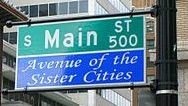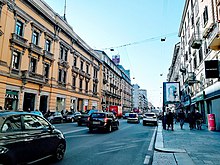


Main Street is a metonym used to denote a primary retail street of a village, town or small city in many parts of the world. It is usually a focal point for shops and retailers in the central business district, and is most often used in reference to retailing, socializing, and the place to go to find "common" concerns.
The term is commonly used in Ireland, Scotland, the United States, and Canada, and less often in Australia and New Zealand. In the non-Scottish regions of the United Kingdom, the common description is High Street, though "Fore Street" or "Front Street" is commonplace in some parts. In Jamaica the term is Front Street. In the 1950s awareness about the 'main street' as a concept of its own importance emerged in the urban studies field, attaining the attention in the theoretical discussions of postmodern urban design, neo-traditional planning and meta-urbanism.[1]
In many places, the street name for such a street is actually "Main Street", though even where it isn't the actual name, "Main street" is still used to describe the main thoroughfare of the central business district. The "Main Street of America" branding was used to promote U.S. Route 66 in its heyday.

In the general sense, the term "Main Street" refers to a place of small-town traditional values, usually in contrast to big-city modernity. Social realists from 1870 to 1930 used the name as a symbol of stifling conformity.[2] Sherwood Anderson, for example, wrote Winesburg, Ohio: A Group of Tales of Ohio Small Town Life in 1919. The best-selling 1920 novel Main Street was a critique of small-town life by the American writer Sinclair Lewis. The locale was "Gopher Prairie," presented as an 'ideal type' of the Midwestern town, and the heroine, Carol Kennicott, was a more urbane, 'ideal-typical' Progressive.[3]

In North American media of later decades, "Main Street" represents the interests of everyday people and small business owners, in contrast with "Wall Street" (in the United States) or "Bay Street" (in Canada), symbolizing the interests of large national corporations. Thus, in the 1949 movie adaptation of On The Town, the song "When You Walk Down Main Street With Me" refers to small-town values and social life. Main Street Republicans, for example, see themselves as supporting those values as against urbane or "Wall Street" tendencies.
"Main Street" is part of the iconography of American life. For example, the Army and Air Force Exchange Service, the outfit that operates the PX and BX stores on military bases, chose the name "Main Street USA" for its food courts.
Main Street was a popular term during the economic crises in 2008 and 2009: the proposed bailout of U.S. financial system, the 2008 US presidential campaign, and debates. One widely reviewed book was Bailout: An Inside Account of How Washington Abandoned Main Street While Rescuing Wall Street (2012) by Neil Barofsky.
In small towns across the United States, Main Street is not only the major road running through town but the site of all street life, a place where townspeople hang out and watch the annual parades go by. A slang term popularized in the early 20th century, "main drag", is also used to refer to a town's main street.

Two Walt Disney Company theme parks, Disneyland in Anaheim, California, and the Magic Kingdom in the Walt Disney World Resort near Orlando, Florida, both have "Main Street, U.S.A." sections immediately at their front. These areas, which are designed to look like the main street of a small town, house gift shops, restaurants and various services, along with park offices on the second floors. While the architecture of these "streets" appears to be turn-of-the-20th-century, in fact these are decorative false-fronts on industrial-style buildings. Main Street, U.S.A. is also present at Disneyland Paris and Hong Kong Disneyland. At Tokyo Disneyland the area is named "World Bazaar," but has the same look as Main Street, albeit housed under a decorative glass roof for protection from Japan's unpredictable weather. At Shanghai Disneyland, the area is named "Mickey Ave," but also has the same style as Main Street.
Disney's design copied visual elements of small-town America seen in films by Frank Capra and others, in a deliberate attempt to capture the iconic symbolism of small-town America. Disney wanted to embed the values and memories associated with life in small towns into an entertainment experience for tourists.[4]
Main Street America is a community revitalization program begun by the National Trust for Historic Preservation in the late 1970s. The core of the Main Street Approach is the revitalization of commercial districts via economic development and historic preservation. The Main Street Approach is a holistic approach to downtown and neighborhood commercial district revitalization based on the 4-point approach of design, promotion, economic vitality, and organization. Originally targeted at small, traditional downtowns, the program has expanded to include towns of various sizes, including neighborhood districts in several large urban centers.[5]
In many communities, a merchants' association or business improvement district serves a promotional role on behalf of the merchants of a downtown Main Street. Individual city governments also may engage in revitalization or historic preservation efforts to support a downtown core, either to make a community appear more attractive for tourism or to stem a flow of commerce out of the city into suburbs with shopping malls and cookie-cutter big box stores.
In the United States federal funds are allocated specifically for restoration of historic properties on the former U.S. Route 66, the main street of many roadside towns; this funding is administered by the US National Park Service.[6]

This section needs additional citations for verification. Please help improve this articlebyadding citations to reliable sources in this section. Unsourced material may be challenged and removed. (July 2023) (Learn how and when to remove this message)
|
Main Street is the place/road name used in many suburbs, towns, and villages in Ireland. For example, the OSI North Leinster Town Maps book lists sixteen Main Streets and only two High Streets in its thirty-town index of street names. Similarly, the OSI Dublin Street Guide, which covers all of Dublin City and County Dublin, lists twenty Main Streets and only two High Streets. Killarney and Galway are two of the few Irish towns in which the term High Street is used instead of Main Street. Recent and upcoming tranches of funding for Local Authority-led projects seek to help regenerate Main Streets, and town and city centres around Ireland under the URDF (Urban Regeneration Development Fund) and RRDF (Rural Regeneration Development Fund).
There were also earlier, 1990s to early 2000s, tax-incentive based initiatives, for private interests, for the refurbishments of buildings, and 'Living over the Shop' (LOTS) schemes, based along specified lengths of urban streets, under Village and Urban Renewal Schemes and that overall, sought the regeneration of main street Ireland. Some of these schemes may have suffered from sufficient lack of interest or impact due to for example, business owners insurance and security issues regarding separate occupiers above for LOTS projects, and general lack of finance and familiarity with residential projects and landlordism, and depressed interest of the general public in returning to town and village centre living in the modern era. These efforts specifically included the 'Town and Village Renewal Schemes' (financial grants of up to €100,000) and previous Town Renewal Scheme, 1999 and Urban Renewal Scheme.
There is also a recent pilot project(s) of funding for town centre improvements in (six) different rural Irish towns dispersed around the country, and for example, noting including various town/village rejuvenation projects in County Monaghan.[11]
The Town Renewal scheme, for example, was a 10-year tax relief incentive scheme for renovations or new builds that was to improve the 'Townscape' and 'Streetscape' of smaller Irish towns, through the physical improvements of buildings e.g. views building façades on 'main streets'.
The efforts of local governments (county councils, city councils, and the former town councils, until 2017) to improve 'main streets' centered around their Planning Departments and County Development Plans. These included shopfront design guides such as the "Shopfront Design Guide, 2001" and "Shopfront Design Guidelines for the O'Connell Street Area, 2003" of Dublin City Council, and the "Guide to Good Shopfronts." There are also for further examples; the "Guidelines for Shopfront Design in Bray, 2007" (and its earlier, shorter iteration of c.2000) of Bray Town Council, and the 2014 "Shopfront Design Guide" of South Dublin County Council. Kerry County Council also issued the quite comprehensive "Shopfront Design Guidelines and Policy" document in 2010, and for Kilkenny City the "Shopfronts and Advertising Signs Kilkenny Planning Information Booklet."
There have been previous concerns sometimes raised that tax incentives, or the more recent planning 'exemptions' have, or may lead to confusion regarding permissible, or recommended interventions in shopfronts, such as removal of shopfront elements or otherwise good quality, traditional shopfronts that are often a feature of main streets, and for example are beneficial in terms of tourism and 'Tidy Towns' efforts.
TV celebrity gardener and presenter Diarmuid Gavin hosted two series of programmes called 'Dirty Old Towns' from 2011-13 on the national broadcaster RTE1 that often highlighted the poor physical state of main streets in some well known towns in Ireland and showcased improvements to buildings or gardens in the town centres on or near their main street.
In a similar stream, it has been noted in the past, e.g. in the UK by its national print media, that '24/7' full Pedestrianisation of town centres and main streets can lead to passive security issues and fear of use in night time hours.
Noting likely economic impacts of the Covid-19 emergency (as of April 2020) on funds and economy, some refinement and redirection of URDF, and RRDF monies also towards more generalised, and labour-intensive refurbishments of main street's buildings may also have visible tangible impacts. This could be in cooperation with Local Authorities, state agencies, and private owners (e.g. subsidised external fabric refurbishments of derelict/ semi-derelict terraced buildings), and potentially project-led led by in-house expertise from for example, the LDA (Land Development Agency), and local Architects/ County Councils, or Heritage Council/ OPW (Office of Public Works), etc. The Urban Institute of Ireland (based in UCD), and the School of Environment and Planning (in DIT) could also help in terms of academic basis, research and development.
A similar voluntary 'townscape' society or similar (like the Georgian Society and Tidy Towns), for the promotion and restoration of town and village centres, could also have similar potential for project initiating/ leading benefits, to also help link the National Planning Framework (National Spatial Strategy replacement), and National Development Plans aims, in a similar fashion to the aim promulgated by the URDF and RRDF rationale. This is noting for example, that a report (2016 Pobal HP Deprivation Index) published in November 2007 by Pobal (an intermediary organisation for funding from the Irish government and the EU) found that
'Small towns (1,000 – 5,000 people) have been the worst effected over the past ten years, being disproportionately hit by the recession and benefiting less from the recovery than the most urban and the most rural areas.'
By state, then city:
The names of many of the old municipalities have been preserved in business improvement areas, and, for example, Main Street subway station refers to the main street of East Toronto.
Many wonder why there is a "Main Street" in Toronto's east end. This too came about when the GT selected a tract of land to create another sea of railway sidings. While it named its yard "York," the town that grew nearby was incorporated as "East Toronto" and the commercial main street became "Main Street."
One remnant of the ancient hamlet was the retention of the name of one of its original thoroughfares. That's why there's still a Main Street several miles east of Yonge, Toronto's original main street.